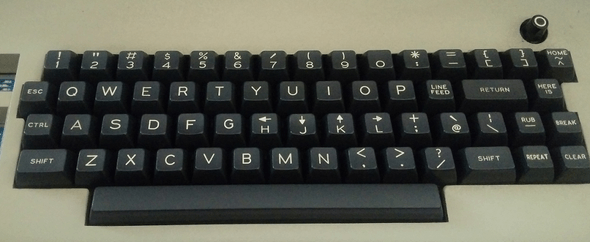How Did Vim Become So Popular
Published Last updated 56,451 views

You probably heard of Vim, the almighty text-editor that is everywhere and a place where people get trapped from time to time. If you are hearing from your local DevOps engineer how Vim is excellent and fast, you probably thought about giving it a try. But how did it come to this? How did Vim-craze take over the world at some point?
If we look at the StackOverflow survey for 2019 about the most popular development environments, Vim is still there on the 5th place, with around 25% of Web Developers using it. Fifth place is pretty neat considering the first Vim release happened almost 30 years ago (yeah, you read that right, Vim got first released in 1991).
To better understand why and how Vim got (and is) so popular, it is best to
look into the roots of how it all started. Before vim, there was vi, before
vi there was ed. What are all these two or three letter words, and
what is the story behind it? Let us dive in and figure out.
Punch cards and line editors
It might be apparent today why we have text editors and fully-fledged IDE (Integrated Development Environment), but what did we have before that? As you may know, early forms of programming involved putting papers with holes (punch cards) inside a computer. The order in which you placed these in was very essential. For example, this is a picture of 4.5 megabytes data, stacked in 62500 punch cards. Imagine dropping that and having to sort it again.

Punch cards proved a bit inefficient as computer power and storage grew, and
programming evolved. Eventually, people moved away from punch cards, and then
there came the era of “line editors.” One great example of this is an
ed editor. Let’s not forget to
mention QED editor,
ed’s predecessor.
Using a line editor
If you are on Linux or Mac OS, open your terminal and type ed. You
will get a simple line editor, which will greet you with silence.
If you are amazed by this finding (as I was), you can try playing with it for a while. To write
a file, start typing a and press enter, then write your text. Typing .
following an enter will exit the append (insert) mode. Then, to write a file, you can
type w myfile.txt and press enter and lastly write q and enter to exit.
# ed a Hey there! I am using ed right now, how cool. OK, that's enough. . w
myfile.txt 64 qAs you may notice, there are similarities between working with ed and with
today’s vim. If you use Vim, you can say you would get the hang of ed pretty
quickly.
Vim’s dad - The Vi
After ed, then came the em - the “editor for mortals”.
It could do similar things as ed, but it is ‘less cryptic’ and built for
regular people. Based on em’s code, Bill Joy developed ex, which
stands for “extended ed”! It was significant because ex had, besides the previous
modes, the visual mode, which will show the whole file on your screen. You
must be thinking - duh, how didn’t they think of that earlier?
Having that thing show up on computers in those days was pretty tricky,
and some considered it a resource hog. But, at that point, the benefits had
outweighed objections, and having a file opened on your screen as you edit it
became today’s standard.

And like that, the visual mode was born. Later, the executable vi got
introduced in operating systems, but you can still access ex commands by
typing : in vi/vim. The ex got released in 1976, and the vi
executable got released in 1979. 40-something years ago! But, how did vim came to life?
The Imitation Game
A couple of years later, many vi clones emerged (my favorite one is
Elvis). One of them was “Vi
Improved” which was created by Bram Moolenaar - the name you now see when you
try to open vim in your terminal. In the large pool of different vi clones,
vim managed to stand out. Bram used a clone of vi called STEVIE (nice
name, BTW), and noticed that it lacks many of vi’s commands. He added
some new features and made it compatible with vi and released it under
the name “Vi Imitation” (this later changed to “Vi Improved”). The name vim came in version 2.0 in 1993 and
stayed like that until the present day. But how did vim achieve fame? It had a
bunch of excellent features
at that time, and it was compatible with vi. Features and compatibility attracted a lot of folks to use it.
Half a century of contributions
If you take a look at the essential commands to move around in Vim: h, j,
k, and l, these all pull roots from the old vi days. Bill Joy’s
keyboard at that time
didn’t have cursors to move around. Also, the ESC key was in the place
of today’s TAB key. Take a look at how it was back in the day:

Commands to replace text like :%s/text_to_replace/text_to_replace_it_with/ is
also something from that era. Having to type : to perform a command
was an answer to ed’s complete silence when you first enter the editor.
What I am trying to say that vim is an effort of over half a century of
good idea accumulation, putting lots of effort into being backward compatible.
Yes, useful features probably made Vim famous. But what kept Vim in the loop is
the compatibility with almost everything you can think about. Wherever you SSH
today, you can start the Vim session, or at least Vi session. That is a strong
(if not the strongest) point to learn it nowadays.
If you’re not someone who jumps from server to server and navigates files on there, the point of having Vim everywhere doesn’t bother you. But still, there are a couple of reasons why it might be valuable to you. I am forming a new blog post explaining why you should learn Vim in 2020. If you are interested in this, consider subscribing to the newsletter.
Final thoughts
Thanks for reading this far, I appreciate it. I hope this blog post shed some light on how Vim became what it is today. I also hope the post inspired you to try it out. You never know when you might need it, or you like it so much that you decide to switch to using Vim fully.
Maybe you get a Vim mode inside your IDE or VSCode, who knows. I am not saying that Vim should replace what you are using now, but trying to learn and configure it will improve your skills and abilities. On the other hand, it doesn’t really matter what editor you use, it is what you do with it!
At the end of the day, it’s the matter of finding the proper editor (tool) that makes you do what you do even better.
If you liked the blog post, you can share it with your friends and coworkers below:
Thanks for reading, catch you in the next one, cheers 🍻
💡 Are you eager to learn Vim or get to the next level with it? Then check out the Mastering Vim Quickly book.
There is a translation in Japanese and Chinese. You can also read the discussion on HackerNews.
Tagged as: Vim
Join the newsletter!
Subscribe to get latest content by email and to become a fellow pineapple 🍍